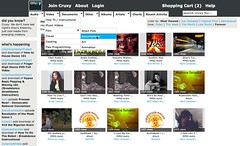This is a repost from the People With Ideas blog aka the Cruxy.com blog.
Cruxy was first envisioned back 2004 as something called “DigiPay” and then “OpenVision”, and then ultimately Cruxy, a crossroads of creativity and commerce. Cruxy is also a rock climbing term for a very difficult climbing problem to solve, like perhaps when you have to cling from your fingertips to a horizontal rock shelf and pull yourself up, sweating, planning and thinking the entire way. That’s a bit how the last four+ years have felt… and we are exhausted.

Jon and Nate in Brooklyn, 2006
Jon and I set out to bring creative people making digital works closer to their audiences, and give them powerful tools to distribute and monetize their content online in any format, price or online venue (blog, virtual world, website, mobile phone) they thought was best for their product. It was a distributed market, meant to empower thousands of other sites, as opposed to trying to own a single audience.
The good news is that while Cruxy never really broke through in the way we hoped, the world, including Apple & iTunes, has shifted to embrace some of the ideals we have always had – open formats, more ways to distribute and promote online, more avenues for niche content to be discovered and heard. People today are watching long-form HD video online (though still much of it is content repurposed from mainstream networks for sites like Hulu.com), downloading podcasts and mashing up and sharing their own original creativity like never before. Rock stars like Radiohead and Nine Inch Nails are completely destroying myths about how the “music industry” should work, while independent musicians like Jonathan Coulton, are proving that through hard work, creativity and ingenuity, that you can quit your day job.

Jon, Nate and Will at the Cruxy Cantina event in 2007
The world has changed for the better, and we are glad for that, but at some point we have to admit, Cruxy is not needed or used by enough people for us to keep going. While we have had an amazing cloud-based business model since day #1 that actual made sense and worked, thanks to my brilliant, co-founder Jon Oakes, we were never able to scale our business up with enough volume to allow us to make an actual living. Our technology platform, built by the incomparable Will Meyer, was a great success in my mind, being one of the first to fully embrace Amazon’s cloud and provide a widget-based commerce system that actually worked!
With all that said, I (Nathan) sent out the letter below, on behalf of the Cruxy team, to our top artists and sellers…
I am writing to let you know that we are going to stop purchases on Cruxy in one week (March 18th), and then ultimately shutdown the service on April 1. All final payouts to you will be made then.
It has been pretty obvious that we haven’t been able to maintain the high level of service we’d like, and to be honest, it is because none of us can commit the time necessary to making the site work as it should anymore. It just isn’t fair to you or the customers to represent our site as being “open for business” when it barely is. This was a very difficult decision as Cruxy has been 100% built and funded by a very small, passionate team. However, times are tough everywhere, whether online or offline, and we need to come to terms with that.
We really appreciate all of the traffic and business you’ve brought to Cruxy, and are writing you directly because we recognize that, and want to make the transition as smooth as possible. We can keep your pages and links up through March, but we will just be turning off the “BUY” option. This way you can provide an alternate link to direct customers to your download destination.
https://www.payloadz.com/ or http://www.e-junkie.com/ are both excellent services that you should be able to migrate over to pretty quickly. We also recommend http://Blip.tv or http://Vimeo.com for hosting high-resolution video (though not for sale).
Drop.io, another Brooklyn-based service, also has an interesting service for paid downloads called PayWall: http://drop.io/paywall
If you have any other ideas or questions about how we can make this process work, let me know. Again, you have been an amazing community of creative artists and digital makers, and we wish you the best in your artistic and business efforts moving forward.
Thanks, everybody, for all of your support. Whatever you do, please keep creating, making, sharing, mashing and living. We need art and inspiration in these times, like never before.
Here’s an early “Best of Cruxy” montage… special thanks to all of you who have been with us since the very early days.
and course, the incomparable HowToDoTheRobot.com crew….
+Nathan



